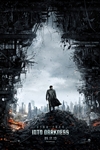- REVIEW
- READER REVIEWS
Star Trek Into Darkness 3D
|
|
Genre
Action/Adventure, SciFi/Fantasy
Producer
J.J. Abrams
Distributor
Paramount
Release Date
May 16, 2013
Release Notes
Nationwide
Official Website
Review
J.J. Abrams’s second Star Trek picture, Star Trek Into Darkness, is so mystically in tune with both the dictates of its studio and the yearnings of its audience that he ought to be anointed Most Reverend Guardian of the Holy Franchises. Even more than its predecessor, the movie is a combination “reboot” and religious revival, the Grail and Da Bomb. It symbolically resurrects the dead and sets a course for the stars—a five-year mission that will introduce fantastical alien races and generate fantastical amounts of money. With a Star Wars picture looming, Abrams is ready for his own Vatican-like country—with a cathedral for Comic-Con conventions.
Is the movie good? It’s hard to be objective. The plotting is clunky and nonsensical, but Abrams and crew bombarded me into happiness. More than that, they made me feel so special for getting the in-jokes. Star Trek Into Darkness is a feature-length dialogue with Star Trek II: The Wrath of Khan: Abrams and screenwriters Alex Kurtzman, Robert Orci, and Damon Lindelhof set the 1982 film’s best-known lines (and best-known scream) in peculiar new contexts. Alliances are muddled—fascinatingly. The narrative never stops twisting.
A word about Wrath of Khan. Apart from reviving the series after the barbiturate that was Star Trek: The Motion Picture, director Nicholas Meyer found the perfect balance between wonky sci-fi and nautical sweep. (It’s amazing how similar the Star Trek template is to Master and Commander.) The film is hard to replicate, though. A sequel to the TV episode “Space Seed” that introduced the genetically enhanced psychopath Khan (Ricardo Montalban), it derives its power from Kirk’s inability to handle late middle age—and from pitting two over-the-hill titans against each other in a starship duel to the death. How can Abrams rekindle that rivalry with younger actors?
Not easily. But in some ways he doesn’t have to. He has a cleanish slate. In Abrams’s first Star Trek, a nobody called Nero (Eric Bana) exploded out of the future to take revenge for the death of his wife and changed history. Kirk (Chris Pine) would now grow up fatherless, wild instead of disciplined. Spock would lose his home planet and be Kirk’s sexual rival, busy making the beast with two backs with Uhura (Zoë Saldana). The old crew would end up together anyway, Kirk winning command of the Enterprise with almost no time served under anyone else. (Poor Riker from The Next Generation got paunchy waiting for his own ship.) In this time line, the discovery of Khan—floating in space, cryogenically preserved with his “family”—has been moved way up.
He’s played by Benedict Cumberbatch, who made Sherlock Holmes his own and now takes on the legacy of a Latin lover with the greatest pecs ever seen on a 62-year-old. Cumberbatch has his own physiological objects of wonder, though: a pair of eyes so wide apart that he looks to have twice the peripheral vision of a normal human. As Khan, he is ravenlike in repose, with a preternatural stillness. He doesn’t worry about the blows that rain down on him. He’s beyond pain. Beyond good and evil, too. He’s not Montalban’s declamatory Ahab. He’s a Nietzschean superman.
What he sets in motion is the most brutal Trek ever, with a mammoth body count and wince-inducing pummelings. The characters keep insisting that the Enterprise is a ship of exploration, not war—while it’s being torpedoed to pieces. I don’t envision calm currents for this crew. And Abrams must have been limbering up for Star Wars: Like George Lucas, he sprinkles every frame with cyber-MSG for the wow factor. A scene in which characters in space suits zoom through a 3-D debris field had me wishing for an airsickness bag.
But does the central trinity still play? Whereas the old Kirk had to navigate between cold logic (Spock) and humanist emotion (Dr. McCoy), the new one is too much of a hothead to listen—making the doctor superfluous and Karl Urban little more than a one-liner machine. But then this whole Enterprise is staffed with quipsters and exhibitionists. Not for Zachary Quinto the still, ever-so-slightly querulous demeanor of Leonard Nimoy. His half-humanity is more like three-quarters, his feelings on the surface. He’s a good actor, but his Spock has no secrets.
The new-model characters are slim and alarmingly smooth-skinned. Anton Yelchin’s Chekhov still doesn’t look old enough to shave. And what’s the deal with his terrible accent? He was born in Russia but makes Walter Koenig look like a veteran of the Moscow Art Theatre. Simon Pegg’s Scotty is not a reassuring presence but an out-and-out hysteric. John Cho blessedly underplays Sulu—and as a result is always upstaged. The pleasure of an Uhura who takes part in the action is dampened by the rest of the role, which requires her either to entreat Spock to be careful or exhort him to get the bad guy. Presumably to offset Saldana’s Na’vi-ish exoticism, there’s a fresh-faced little blonde (Alice Eve) who’s supposedly the young Carol Marcus (Bibi Besch in Wrath). Looks like the next one could channel that old porn standby, Star Trek III: The Search for Cock.
For all the movie’s off notes, it has something you can’t buy: the vibe of fan fiction. Imagine: fan fiction with a huge budget and a cast that, if you squint, looks like our old crew. Abrams has a gift for making us feel as if Star Trek Into Darkness vaulted from our own Trek-ish daydreams. He’s peddling ownership—and rebirth.
Related Stories
New York Magazine Reviews
- David Edelstein's Full Review (5/20/13)
